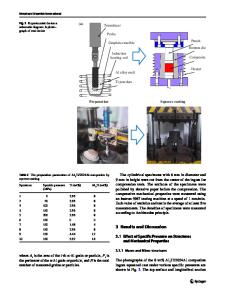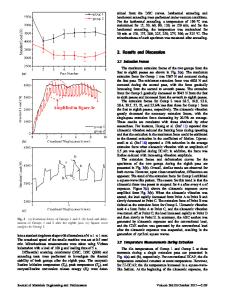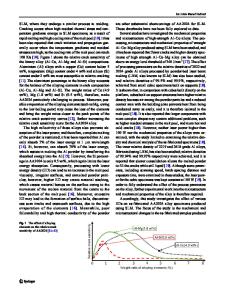Microstructure and Mechanical Properties of CNTs/A356 Nanocomposites Fabricated by High-Intensity Ultrasonic Processing
- PDF / 2,714,805 Bytes
- 9 Pages / 593.972 x 792 pts Page_size
- 92 Downloads / 334 Views
INTRODUCTION
ALUMINUM (Al) matrix composites are an important group of structural and functional materials, which have been widely used in the aerospace and automotive industries. In recent years, high-strength nanoparticle-reinforced Al alloy composites have garnered considerable attention from researchers and developers due to their relatively low density, high specific strength and stiffness, and good machinability, and they have great potential application in industry.[1] Since the discovery of CNTs, their unique conductivity, high strength, structural stability, and other fascinating properties have made them ideal candidates for composite reinforcement application.[2,3] Many studies have shown that the addition of CNTs to Al alloys significantly improved their mechanical and anti-attrition properties.[4,5] However, the dispersion of CNTs is one of the main challenges in fabricating CNT-reinforced metal matrix composites due to the Van der Waals force of CNTs. Also, the CNTs are not wetted by matrix melt due to their large specific surface and high interfacial energy. Meanwhile, the interfacial reaction between CNTs and the Al matrix occurred when the processing temperature was above about 800 K (527 °C),[6,7] which HONG YAN, Professor, and ZHI-XIANG HUANG and HONGXU QIU, Postgraduate Students, are with the School of Mechanical Electrical Engineering, Nanchang University, Nanchang 330031, China, and also with the Key Laboratory of Light Alloy Preparation & Processing in Nanchang City, Nanchang 330031, China. Contact email: [email protected] Manuscript submitted August 25, 2016. Article published online November 28, 2016 910—VOLUME 48A, FEBRUARY 2017
results in the formation of brittle Al3C4 and damage of CNTs. To this effect, several fabrication methods, such as the power metallurgy method,[8] the in-situ reaction method,[9,10] the stirring casting technique,[11] and hot rolling ball-milled powder techniques,[5] have been used to fabricate CNT-reinforced metal matrix composites. However, the powder metallurgy method is not suitable for producing complex shaped components, and the defects of porosity and crack are readily generated. The in-situ reaction method causes the burning loss of alloy elements due to the high reaction temperature. Using the mechanical stirring method, it is difficult to disperse the cluster of CNTs when the CNT content is high.[12] In addition, most of the available fabrication routes are complex and expensive, making them unsuitable for commercial production. Ultrasonic treatment is always applied to disperse the cluster of nanosized particles in the melt. Chen and Yan[13] studied the nanosized Al2O3-reinforced Al7075 Al matrix fabricated by subtype multifrequency ultrasonic vibration. The results showed that Al2O3np particles homogeneously dispersed in the matrix, and the mechanical properties (ultimate tensile strength (UTS), ultimate compressive strength, and microhardness) showed superior improvement. Liu et al.[14] successfully produced 1.5 wt pct CNTs/AZ91D nanocomposites by high-intensi
Data Loading...











